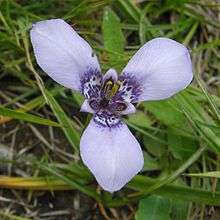Herbertia (plant)
| Herbertia | |
|---|---|
 | |
| Herbertia lahue | |
| Scientific classification | |
| Kingdom: | Plantae |
| (unranked): | Angiosperms |
| (unranked): | Monocots |
| Order: | Asparagales |
| Family: | Iridaceae |
| Genus: | Herbertia Sweet |
| Type species | |
| Herbertia pulchella Sweet | |
| Synonyms[1] | |
Herbertia is a small genus of herbaceous, perennial and bulbous plants in the Iris family (Iridaceae).[2]
Description
Herbaceous and perennial plants, from tunicate, ovoid bulbs with brown, dry, brittle and papery tunics. The stems are simple or branched. The leaves are few, with the basal ones larger than the others; the blade is pleated, linear-lanceolate.
Taxonomy
Herbertia consists of 8 accepted species. One of them is native to southeastern + south-central United States, while the others are distributed in South America.[1] The genus is closely related to Alophia, Cypella, and Tigridia.
The name of the genus is dedicated to William Herbert (1778–1847), a prominent British botanist and specialist in bulbous plants.[3]
- Species[1]
- Herbertia amatorum C.H.Wright - Uruguay
- Herbertia darwinii Roitman & J.A.Castillo - Rio Grande do Sul State in Brazil, Corrientes Province in Argentina
- Herbertia furcata (Klatt) Ravenna - Uruguay, southern Brazil, Misiones Province in Argentina
- Herbertia hauthalii (Kuntze) K.Schum. - Paraguay
- Herbertia lahue (Molina) Goldblatt - southern Brazil, northern Argentina, central Chile, Uruguay, southern United States (Texas, Louisiana, Mississippi, Florida Panhandle)[4]
- Herbertia pulchella Sweet - Colombia, Venezuela, Bolivia, Uruguay, southern Brazil, northern Chile, Salta Province in Argentina
- Herbertia quareimana Ravenna - Uruguay, southern Brazil
- Herbertia tigridioides (Hicken) Goldblatt - Bolivia, northern Argentina
- Herbertia zebrina Deble - Rio Grande do Sul State in Brazil
References
- 1 2 3 Kew World Checklist of Selected Plant Families
- ↑ Goldblatt, P. (1978). Herbertia reinstated as a valid generic name. Annals of the Missouri Botanical Garden 64: 378-379.
- ↑ Manning, John; Goldblatt, Peter (2008). The Iris Family: Natural History & Classification. Portland, Oregon: Timber Press. pp. 243–46. ISBN 0-88192-897-6.
- ↑ Biota of North America Program 2013 county distribution map
- Goldblatt, P. Flora of North America: Herbertia.
- Peter Goldblatt. Herbertia (Iridaceae) Reinstated as a Valid Generic Name. Annals of the Missouri Botanical Garden, Vol. 64, No. 2 (1977), pp. 378–379
External links
This article is issued from Wikipedia - version of the 5/31/2016. The text is available under the Creative Commons Attribution/Share Alike but additional terms may apply for the media files.